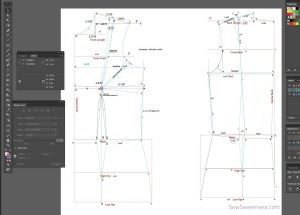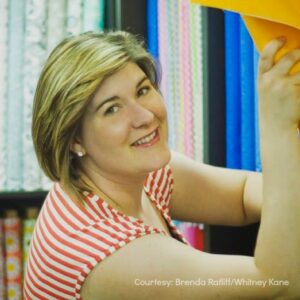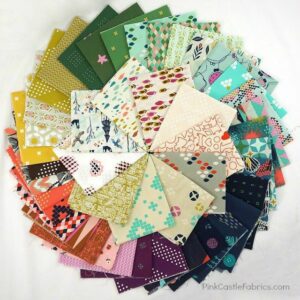It’s a question many of us have, but how can you make it a reality?
Two sewing industry professionals weigh in – Sara Lawson of Sew Sweetness and Brenda Ratliff, owner of Pink Castle Fabrics.
There’s something you need to know about people who sew.
It’s not just a casual hobby as you might assume, but a dedicated lifestyle.
And like many others, I could and would do it 24/7 if I didn’t have any other obligations. After all, who needs to vacuum or do laundry?
Not to mention that thing called work…
But what if you could do it all day (and night) long for a living? As I found out from fellow quilters in the Quiltonomics article, it can be tough to command the right price for sewn goods.

Sara Lawson – popular fabric and pattern designer, author, and blogger at Sew Sweetness – knows the struggles of making a living in the sewing world.
In 2010, Lawson started her blog to showcase whatever project she was working on each week as she learned the ins and outs of sewing. She had two young children, and enjoyed time at the sewing machine while they slept. The next year she began writing free patterns for the Pellon Projects website.
“There was no goal at the time of really doing anything with sewing besides having fun,” admitted Lawson. “But I found that I was good at bags and writing patterns that people could understand, so I kept going.”
After offering PDF patterns online and finding early success through her blog and social media, she moved into paper patterns in physical stores.
“I have to say that I was really embarrassed when I first started designing bags, because all of my friends were quilters and were coming out with quilt patterns,” Lawson said. “I felt like I was the odd one out. Quilt designs just weren’t easy to me. But now I’m glad that I do what I do.”
According to Lawson, she feels the factors for her success include working very hard and not setting out with specific expectations to meet. She also stresses that she doesn’t use debt to finance her business.
“I operate by paying for everything up front (printing costs, Quilt Market booth, etc.) and not involving any credit cards,” advises Lawson. “If I don’t have enough money to do something, I don’t do it. I think this has alleviated a lot of the stress that comes with running a business.”

A common misconception about anyone who sews is that the only way to make money from it is by selling finished, handmade items. Lawson even confesses that she once tried her hand at peddling fabric on eBay and burp cloths on Etsy.
“I quickly learned that neither of these was the correct path as I wasn’t earning any money,” she recalled. “I’m not interested in selling handmade goods. I know there are people who are successful with it (and more power to them!), and I really appreciate and admire what they do. When I make a bag for a pattern, I usually only make it once initially. My mind is always racing, so I’d prefer to write a new pattern than sew the same thing over and over again.”
Lawson told me she really felt like she had “made it” professionally in the sewing/quilting industry when she was first asked to teach at the Sewing Summit, and when she wrote her first book “Big-City Bags.”
Breaking into this field is not normally easy or quick. It’s taken Lawson five years to get to this point in her career, and she says there are indeed obstacles.
“Managing social media and blogging are big hurdles,” acknowledges Lawson. “You need to be creative, and be able to promote yourself in person and online in order to be successful. Blogs used to be the ‘thing’ when I first started, but that’s not so much the case anymore. So many fabric lines are released each year, it sometimes feels challenging for any one thing to stick out and be noticed.”
Not too long ago, Lawson was teaching at Camp Stitchalot – working with Brenda Ratliff – owner of Pink Castle Fabrics and host of the popular destination sewing retreat.

Like Lawson, Ratliff started quilting as a hobby. After the birth of her son, she decided to accept a new opportunity: Mom. She became engrossed in books, blogs, and voraciously learning about everything there was to know about quilting. However, Ratliff found it difficult to source the modern fabrics that she wanted to use – so she started her own online shop in 2011.
Her beginnings were humble, with the family home’s basement serving as a warehouse for inventory. In 2013, a brick and mortar location opened up in Ann Arbor, Michigan.
“I believe my success comes from being a part of the quilting culture,” Ratliff said. “I’m active on social media (Instagram mostly) and I quilt and sew all the time both for work and fun… I enjoy my job and love fabric. I think that shows to our customers.”

Together, the two women came up with the idea for a convention to teach others how to work within the sewing/quilting world.
“Knowledge seems to be the thing that is lacking,” Ratliff observed. “I have so many people ask me, ‘How do I submit a pattern to a magazine?’ Or ‘I want to write a book, but I don’t know where to begin.’ Also, the knowledge of what to expect to actually get paid for these things.”
“So many people have helped me by answering my questions along the way, and it can be quite daunting if you have to figure everything out yourself,” admitted Lawson. “Brenda thought it should be in a central part of the country, like Chicago – where I happen to live. We decided to go for it!”
 The inaugural Sew Pro Convention takes place in Chicago, September 15-18, 2016 at the Hyatt Regency O’Hare in the Rosemont district. It’s the perfect chance for you to see firsthand what it really takes to become a professional in this community.
The inaugural Sew Pro Convention takes place in Chicago, September 15-18, 2016 at the Hyatt Regency O’Hare in the Rosemont district. It’s the perfect chance for you to see firsthand what it really takes to become a professional in this community.
Four career “tracks” will be offered including fabric designer, pattern designer, author, or blogger.
“Sew Pro really came from all the customers asking me questions about how to become a professional in the industry,” Ratliff explained. “A lot of other designers I know get asked the same things. Quilt Market is a great place to meet people in the industry, but it’s really a trade show for fabric stores to buy fabric. It’s not the ideal place to market yourself, or the best place to learn about opportunities in the business. I wanted to create a place that is the right venue for that – a place where questions can be answered and new ideas can be shared. Then you can make an informed decision about becoming a sewing professional, and where you fit into the industry.”
An opening mixer will be held on Thursday night before classes begin, in order to meet other students and teachers in a casual atmosphere.
Two full days of seminars and classes are scheduled for Friday and Saturday.
There will also be an area set up for companies to show off products and tools that can help you with your sewing-related business.
And the teacher roster includes an impressive list of movers and shakers:
- Tula Pink
- Pat Sloan
- Alison Glass
- Sarah Watts
- Sara Lawson
- Mickey Krueger, Windham Fabrics
- Kristin Link, Sew Mama Sew
- Jenny Fox-Proverbs, Love Patchwork & Quilting
- Roseann Kermes, quilt shop owner
- Lora Douglas, CPA
- Brie Crawford, Intellectual Property and Entertainment Law Attorney
- Deb Hanahan, buyer at Checker Distributing
- Jane Melville, Tri-State Printing
- Karen Lepage, garment designer and pattern writer/illustrator
“I am still amazed when I look over the class list,” Lawson stated. “Even as someone who already has a sewing-related business, I want to take many of these classes myself. The teachers are all experts in their field, and Sew Pro is truly going to be a wonderful and extremely valuable event. If you are aspiring for a career in the sewing industry, there’s nothing better than having the president of a fabric manufacturer, the editor of a magazine, or the founder of a publishing house right in front of you with a few minutes to chat in between classes.”
According to Ratliff, Pat Sloan and Tula Pink will both be keynote speakers.
“Pat has written over 30 books, and does a lot of teaching engagements, designs fabric for Moda, and has an excellent podcast she’s been doing for years,” said Ratliff. “Tula is also an author and teacher. She really shines with her fabric collections. She’s an incredible artist, but most of all – she knows how to market her brand. She has built up such a local following. Pat and Tula know how to get their fabrics in the hands of the right bloggers, how to write a great pattern, how to include quilters on social media, and of course – how to make amazing quilts!”
Sew Pro will also host fun after-hours events to get attendees mingling with themselves and the teachers.
“I know from attending Quilt Market each year that networking is a really important part of doing business,” insists Lawson.
“Think about not only the industry professionals you are going to meet, but also the other folks just like you,” Ratliff said. “You might be a quilt pattern designer and you meet a blogger at Sew Pro. You now have a friend that you can send a free pattern to, and she can help you promote it on her blog. And that blogger can come to you to help create a pattern for a sew along or tutorial for her blog. Knowing other people in the industry is key!”
Registration is now open for Sew Pro, and there are 6-month and 12-month payment plans available for the $550 tickets. Free shuttle service is available from Chicago O’Hare International Airport to the hotel – which is only two miles away.
Both Lawson and Ratliff do believe it’s possible to make an income in the sewing and quilting space, and have created this opportunity to learn how to get started.
“There has definitely been big growth over the past few years,” Ratliff declared. “The industry is now seeing the modern segment of quilting as a revenue source, so we are seeing a lot more modern fabric and quilt designs. There will still be changes in the near future, and I think there will be even more people discovering sewing as a hobby. I love that the attitude of helpfulness and sharing is still around. We see so many swaps, sewing for others, and people willing to impart their knowledge to beginners and other quilters.”
[…] Valuing quilts at a higher price would give the entire industry a shot in the arm. It would allow more hobbyists (like me!) the opportunity to quilt for a living, and attract new eyes to a lucrative art form. (Can you really make a living sewing?) […]